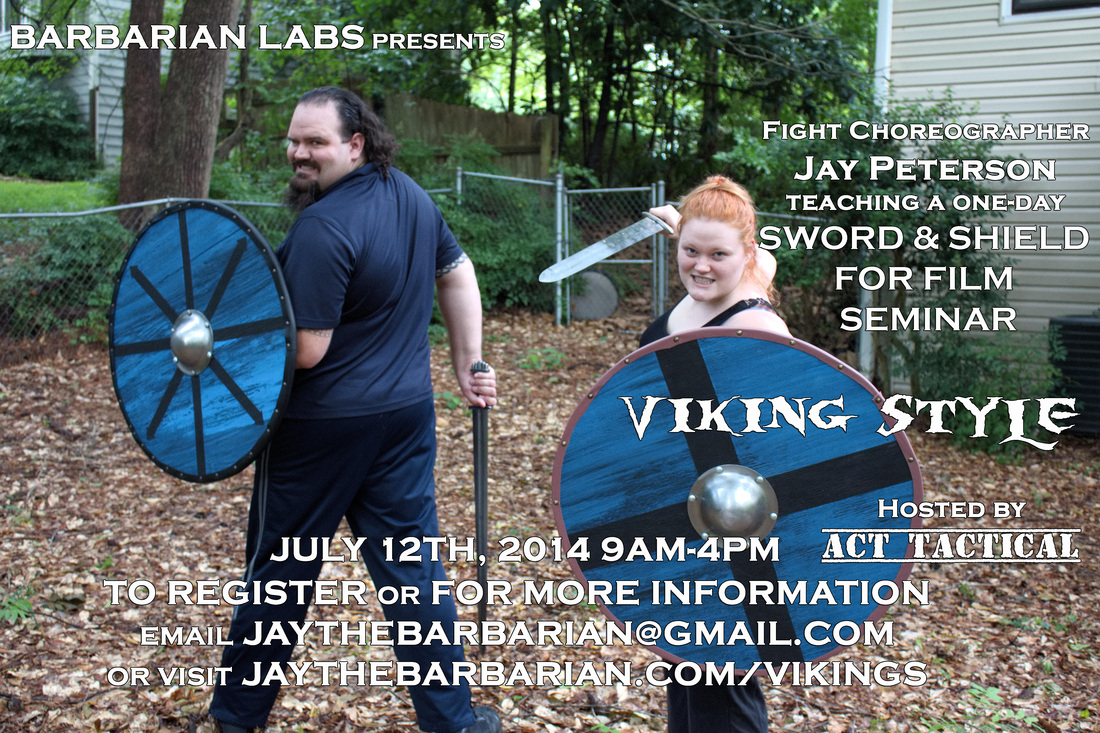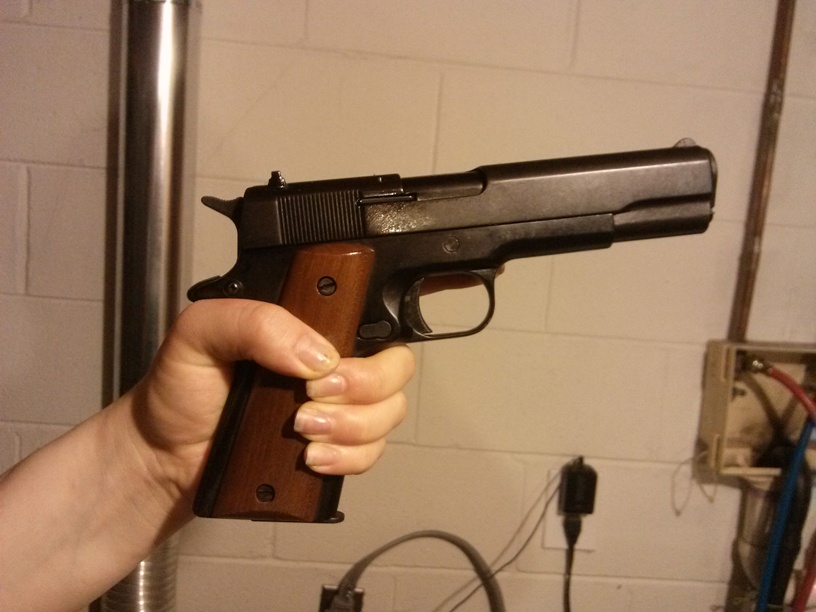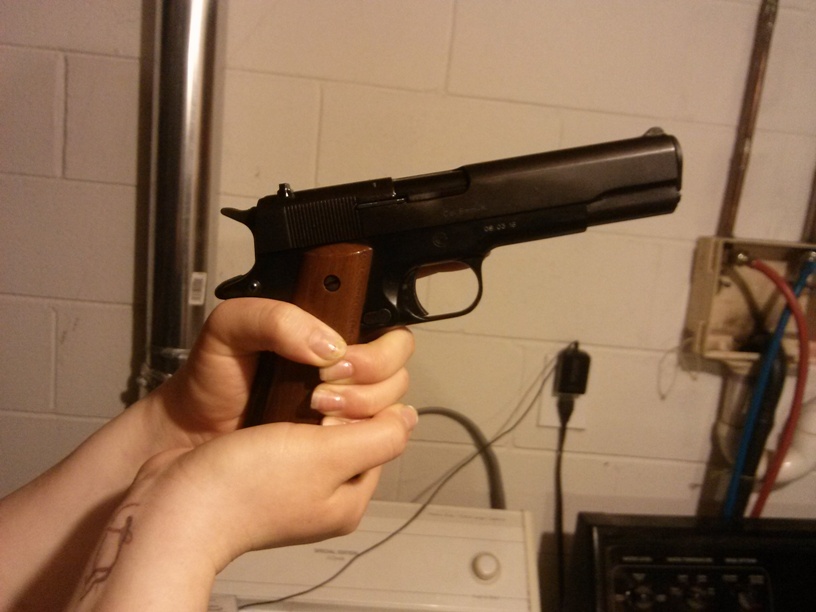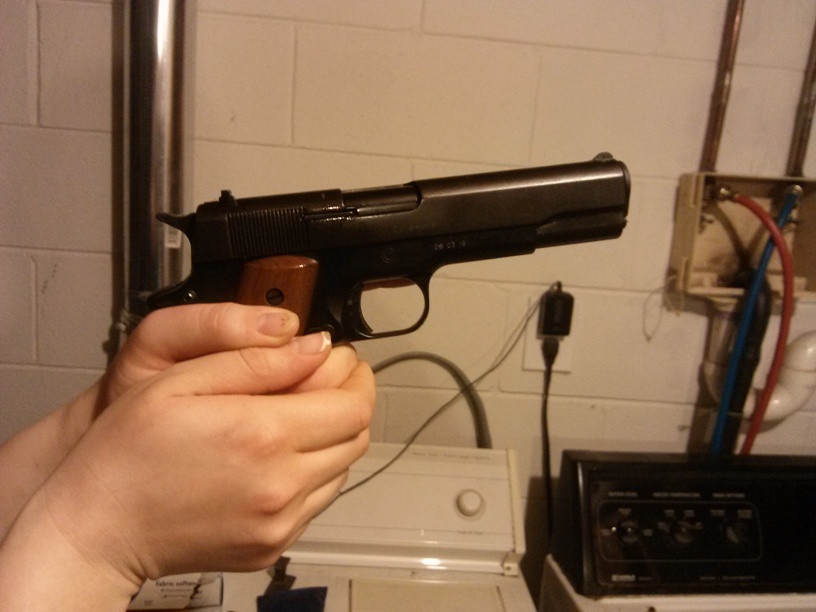On top of that, I'm about to pack some knives, shirts, and other fun to head down to vend at the National Stage Combat Workshop in NC. I've been twice as a student and a handful of times as a vendor. If you're into fighting for an audience, it's three weeks of some of the best training possible.
|
Busy, busy, busy over here at the Labs. Among other things, I've been doing a lot of knife throwing lately. Yesterday the Lady had a party, several guests of which tried their hand at it. Most did pretty good. The above is an intermediate stage of something I've been working on, punctuated by what a friend calls "The Barbarian Voila." I like it. In other news, I'm teaching a one-day Sword & Shield for Film seminar focusing on Viking styles. It'll be down at the production centre at Pinewood Studios Atlanta. Follow the directions on the pic to learn more.
On top of that, I'm about to pack some knives, shirts, and other fun to head down to vend at the National Stage Combat Workshop in NC. I've been twice as a student and a handful of times as a vendor. If you're into fighting for an audience, it's three weeks of some of the best training possible.
0 Comments
Last time I talked about the UCSB murders, it focused on being Schrodinger's rapist, and the effect that has on life, and how much it's becoming a fact of life for more and more people.
But the more I've thought about it, the more I realize I also could fall into another category. This particular one I've seen from both the inside and outside. Almost universally disliked by every awkward male to ever walk the earth. And while the UCSB scumbag's main target of scorn and violence was women in general, number two on his shit list was this particular well-known specimen. He is known by many names and types, but his nature is always the same. He is The Guy Who's Getting Laid When You Are Not. Just about everyone male who read this recognized him once I spoke of his nature. Oh Him? Fuuuuuck that guy. What a prick. Maybe he's not the recipient of outright hate. Sometimes it's just frustration. Envy. And just head-shaking incredulity. And yeah, I've encountered That Guy in my younger days, and had the low-level grumbly reactions. I like to think I've handled such encounters better than most, but nostalgia and wishful thinking may be clouding memory. And about once a year it is pointed out to me that I am That Guy. It's almost always at an event of some sort, and following some sort of Attack-Harem-related shenaniganry. I get pulled aside by a gent and asked a variation of "How did you just wind up with both the attention and affection of multiple ladies just now?" The questioners run the gamut. Some are clearly really asking, "I do not speak the language of these strange but irresistibly nice-smelling, curvy people. Please help me to not embarrass myself while I pursue further discourse." Others are inquiring more on the lines of "Dude! I don't know what sort of sorcerous panty-dropping app you have on your phone but I NEED it! Tell me!" I've done my best to answer somewhat helpfully in the past. But seeing the mindset of the UCSB killer, I'm both glad I took the time and wish I said more. Because for every one that did actually ASK, how many just watched and let the bitter and the hatred grow a touch more? The big things I think I'd mention if asked today... - Nobody you've seen me with owes me squat. Not their presence, not their affections, period. They are there because they want to be. That's it. - Appreciation, not objectification I'll admit this one is hard to define or analyze. It's also damn near impossible to fake. No gents, you don't have to avert your gaze if an acquaintance is cleaning up good. But we do look at objects that draw the eye differently than we do people that do the same, and looking at the latter like the former doesn't go over well. - Fuckups happen. Own them and move on. Every time I've been pulled aside and furtively questioned, it's followed some sort of weapons-grade flirtation on my part. And the questioner is almost invariably comparing the equivalent of my highlight reel to their own stumblethrough rehearsal. I'll be the first to admit: I've fucked up. A lot. Whether it's approaching the uninterested to dodging hits with a clue-by-four all the way up to being granted citizenship in the country of Assholeistan, population: me. As the years roll by I fuck up less and either atone or withdraw in classier fashion, but a good chunk of that is a hard road of experience (and in a lot of cases, observation. Learning from other people's fuckups is easier on your own mileage). - I haven't had sex with nearly as many of them as you think Not only that, I'm not even sleeping with the vast majority. (Wait for it. Remember I speak in literal terms... and the lightbulb goes off.) There's no real delicate way to make a euphemism for that one. We unfortunately live in a society that declares "being physically close/visibly affectionate = sexual relationship." And in my case, at least, that's bullshit. The term "Attack Harem" is a joke collective name for various friends of mine who happen to be both ladies and a tad overprotective. (One threatened to invade Iraq personally if anything happened to me). Yeah, I'm affectionate, yeah, I'm flirtatious. I'm also big believers in A ) everyone setting their own personal limits and respecting those of others, and B ) living my life without the bullshit notion that intimacy and sensuality are impossible to have and enjoy outside of sex. As far as those I really am whatever and how? Nobody's business but mine, theirs, and any applicable significant others. That alone is worthy reason. Add in my inherent defense of other people's secrets and the bullshit societal double standard that always, always comes down harder on ladies in such arrangements, and it all adds up to that's all you're getting out of me. So there you have it. Long, confusing in spots, and brings more questions than answers. Still, I can hope it spreads more thought than hate. Yep. You read that right. I'm justifying teacupping. Hell, I've done so once in a private class and once on a gig in the past month, I might as well keep at it. For those who don't know what I'm talking about, "teacupping" is a derogatory term used for a certain way of gripping a handgun that's currently out of favor. In fact, nowadays I'd have to say in the top ten of "things to make your firearm advisor happy on set," "not teacupping" might rank just below "calling it a magazine, not a clip," and "not flagging me." So, what is it? What makes it a bad thing? (if it even is a bad thing?) Why the bad rap? History lesson time. For the bulk of its existence, the pistol was a one-handed weapon. Once technology could scale down from the "handgonnes" of earlier times, the pistol became a favored backup weapon alongside the saber and cutlass, not to mention reins or rigging. Until WWI, U.S. Army holsters were designed to cross-draw, reflecting a right-handed officer's instinct to use the sword with the right hand and pistol with the left. Here and there, two-handed grips were used for whatever reason, but on an ad hoc basis. It's my personal belief that the first use of a two-handed grip was what we now call The Teacup. This grip is almost invariably the first two-handed grip that an untrained shooter uses. The reason is simple. With the pistol operable with one hand, the other is relegated to a support role. The most immediately needed support to a new shooter the vast majority of the time isn't against recoil, but against weight. Pistols are heavy, so the support hand naturally rests under the butt to take some of the weight off of the shooting hand. Looking at it this way, teacupping is the untrained, but natural and instinctive response to having to hold a pistol two-handed. It felt so natural the U.S. Army was recommending it in WWII. (Teacupping ensues at 5:20) So, if teacupping is a natural and instinctive response, what's the big deal? Well, the major sin of teacupping these days is inefficiency at worst. When actually shooting, the support hand offers no support against the force of the shot (what with coming from the wrong direction and all), leaving the shooting arm to absorb the recoil. There's a couple different ways to be more efficient. Jack Weaver took a teacup and turned it into a sort of piston grip by having the support hand pull back while the shooting hand pushed forward. This helped get the pistol back on target after the force of the shot lifted the muzzle up. The most popular grip these days, however, seems to be a wraparound of one kind or another. In this particular case, the support hand comes up on the side, fingers sliding into the grooves left on the grip by the fingers of the shooting hand. The shooting hand's thumb curls down and forward, paralleling the thumb of the support hand.
(Hint: if you ever hear gun enthusiasts yell "thumbs forward!" while watching an action scene, this is what they're talking about.) What this grip ends up doing is keeping the grip balanced between both hands, giving the shooter the strength of both arms (and in some instances, the torso) to alleviate the effects of recoil. That's pretty much it. So, why teacup in a gunfighting scene if you know that? Any number of reasons: an untrained character, a period piece (wraparound grips didn't become popular until the great pistol technique argument was kicked off by folks like Cooper, Weaver, and Chapman in the late 50's-early 60's), character fatigue or injury (where a steady shot is more important than recovery for follow-up shots), or any number of other reasons. I can recognize the teacup isn't the best grip out there. But it's there for a reason. And knowing why and how lets me and my performers come to a more informed choice, and ultimately, a more nuanced story. ~J. |
Jay Peterson
Musings on violence, storytelling, and humanity in general. Archives
December 2023
Categories
All
|






 RSS Feed
RSS Feed
